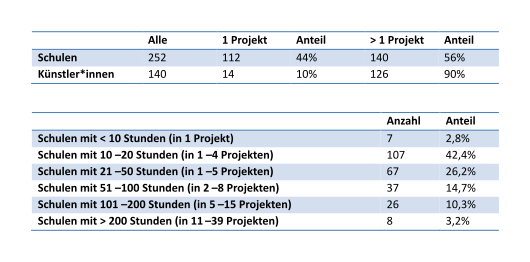Only very limited reliable statements can be derived from the available database on the topic of establishing and promoting long-term collaborations. One of the reasons for this is that it is not possible to clarify the extent to which schools or artists have reapplied with further individual project ideas following an initial collaboration, but were ultimately unable to be considered with their project plans in the award procedure for the respective year due to the limited number of hours or excessive travel costs.
In the following, we will therefore at least begin to shed light on the number of one group with which the other group generally cooperated. Here it becomes apparent that schools usually seek and maintain cooperation with only a few artists. Artists, on the other hand, are far more open to collaborations with new schools, although in this group, the continuation of a collaboration with one or more schools over many years is also clearly pronounced and preferred.
The same can be said of the consistency of the partnerships entered into. The high number of one-off collaborations on the part of the artists clearly shows that even if they participate in the overall project several times, the continuation of a collaboration with a school once it has been established is the exception rather than the rule. Despite repeated participation, this also applies to the schools as project participants. At the same time, however, it can be seen here that with an increasing number of projects, the collaboration with several artists is generally far less diverse.
Finally, in this context, the proportion of one-off projects (not participation) of the two groups of actors, schools and artists, should be compared and, in the case of schools, the total number of hours spent on all individual projects should also be considered.

